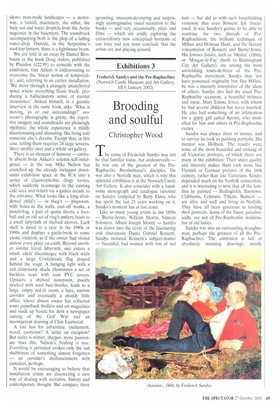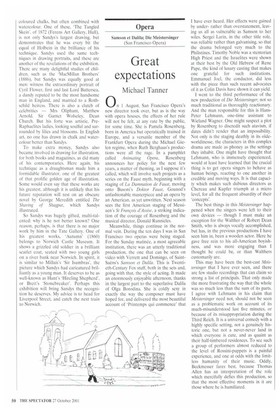Exhibitions 3
Frederick Sandys and the Pre-Raphaelites (Norwich Castle Museum and Art Gallery, till 6 January 2002)
Brooding and soulful
Christopher Wood
The name of Frederick Sandys may not be that familiar today, but undeservedly — he was one of the greatest of the PreRaphaelite Brotherhood's disciples. He was also a Norfolk man, which is why this splendid exhibition is at the Norwich Castle Art Gallery. It also coincides with a handsome monograph and catalogue raisonne on Sandys, compiled by Betty Elzea, who has spent the last 25 years working on it. Sandys's moment has at last come.
Like so many young artists in the 1850s — Burne-Jones, William Morris, Simeon Solomon, Albert Joseph Moore — Sandys was drawn into the circle of the fascinating and charismatic Dante Gabriel Rossetti. Sandys imitated Rossetti's subject-matter — beautiful, bad women with lots of red hair — but did so with such breathtaking virtuosity that even Rossetti felt threatened. It was Sandys's genius to be able to combine the two threads of PreRaphaelitism, the brilliant technique of Millais and Holman Hunt, and the literary romanticism of Rossetti and Burne-Jones. His fames fatales, such as 'Medea' (1866), or 'Morgan-le-Fay' (both in Birmingham City Art Gallery), are among the most astonishing tours-de-force of the PreRaphaelite movement. Sandys may not have possessed originality but, like Millais, he was a masterly interpreter of the ideas of others. Sandys also had the usual PreRaphaelite accessory, a beautiful mistress and muse, Mary Emma Jones, with whom he had several children but never married. He also had something of an infatuation for a gypsy girl called Keomi, who modelled for him and others in Pre-Raphaelite circles.
Sandys was always short of money, and to survive he took to painting portraits. His mentor was Holbein. The results were some of the most beautiful and striking of all Victorian portraits, of which there are many in the exhibition. Their sheer quality and intensity makes them look more like Flemish or German pictures of the 16th century, rather than late Victorians. Sandys depended much on his Norfolk connection, and it is interesting to note that all the families he painted — Bedingfelds, Barstows, Clabburns, Colmans, Tilletts. Bulwers — are alive and well and living in Norfolk. They have all been generous in lending their portraits. Some of the finest, paradoxically, are not of Pre-Raphaelite maidens, but of old ladies.
Sandys was also an outstanding draughtsman, perhaps the greatest of all the PreRaphaelites. The exhibition is full of absolutely stunning drawings, mostly coloured chalks, but often combined with watercolour. One of these, 'The Tangled Skein', of 1872 (Ferens Art Gallery. Hull), is not only Sandys's largest drawing, but demonstrates that he was every bit the equal of Holbein in the brilliance of his technique. Sandys used the same techniques in drawing portraits, and these are another of the revelations of the exhibition. There are many delightful studies of children, such as the 'MacMillan Brothers' (1886), but Sandys was equally good at men: witness the extraordinary portrait of Cyril Flower, first and last Lord Battersea, a dandy reputed to be the most handsome man in England, and married to a Rothschild heiress. There is also a clutch of celebrities — Mrs Oliphant, Matthew Arnold. Sir Garnet Wolseley, Dean Church. But his forte was artistic, PreRaphaelites ladies, looking soulful and surrounded by lilies and blossoms. In English art, no one has drawn in chalk and watercolour better than Sandys.
To make extra money, Sandys also became involved in drawing for illustration, for both books and magazines, as did many of his contemporaries. Here again, his technique as a draughtsman made him a formidable illustrator, one of the greatest of that prolific golden age of illustration. Some would even say that these works are his greatest, although it is unlikely that his future reputation will rest on an obscure novel by George Meredith entitled The Shaving of Shagpat, which Sandys illustrated.
So Sandys was hugely gifted, multi-talented: why is he not better known? One reason, perhaps, is that there is no major work by him in the Tate Gallery. One of his greatest works, 'Autumn' (1860) belongs to Norwich Castle Museum. It shows a grizzled old soldier in a brilliant scarlet coat, seated with two young girls on a river bank near Norwich. In spirit, it is similar to Millais's 'Sir Isumbras', the picture which Sandys had caricatured brilliantly as a young man. It deserves to be as well-known as Hunt's 'Hireling Shepherd', or Brett's `Stonebreaker'. Perhaps this exhibition will bring Sandys the recognition he deserves. My advice is to head for Liverpool Street, and catch the next train to Norwich.











































































 Previous page
Previous page